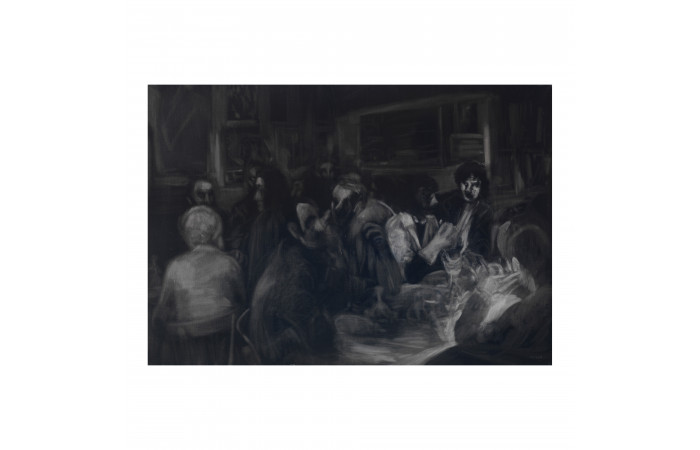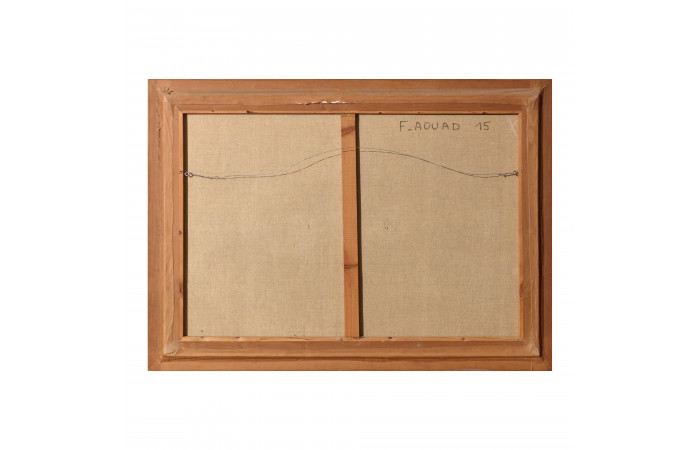Le Café (Scene at a Café, 1975 -1978)
Description
Medium: Oil on canvas
Size: 116.4 x 81.2 cm (with frame 126.5 x 91 cm)
Signed Aouad on the front lower right and F. Aouad on the back
Provenance
Directly from the artist; Private collection Lebanon
Location
Kaslik, Lebanon
Description
Farid Aouad (1924-1982) was perhaps the most Parisian Lebanese artist. He spent most of his life in the French capital, where he painted and drew scenes of daily life, including people walking in the streets, theatres and cafés.
Aouad, born in South Lebanon, was, in 1943, part of the first promotion at the School of Painting (the present School of Visual Arts) at the Académie Libanaise des Beaux-Arts (Alba). In the late 1940s, he travelled to Paris, where he spent two years at the Beaux-Arts and worked in the studios of fauvist artist Othon Friesz and cubist painter and writer André Lhote. He returned to Lebanon before settling definitively in Paris in 1959. His path became associated with an image of sickness and misery. In his Dictionary of Lebanese Painting, Michel Fani writes that “the man who coughed and spat blood in his atelier rue des Haies was not a doomed artist. Though he painted the memories of a world where colour was not anymore, like a blind staggering in the dark.”
Aouad’s poor living conditions are recurrently mentioned to explain the darkness of his palette and the blurriness of his textures. However, whether these reasons were accurate or not, the “black” paintings he produced, including the present one, transcend the tragic into a fascinating construction of ghostly figures. This feature generates the entire difference between Aouad and the depictions of that same subject produced in the previous century by Manet, Degas and Toulouse Lautrec.
The cafe scene is composed of two planes, each corresponding to a table. In the foreground, the first table, covered by a white sheet, is occupied by various people. One man, seen from behind in the lower right, two persons discussing in front of him, and two other men, with darker faces, further towards the left. The second table is organised in a more compact way; thus, the characters are less visible. The composition is very dynamic due to its perspective, with two walls rejoining each other in the middle line. Covered with mirrors and images, these walls paradoxically contribute to dematerializing the entire space of the painting into a dreamy – or nightmarish – vision.
The works of art which are subject to artist resale royalty rights ('droit de suite') are marked with an * in the description of the work of art. The amount of the royalties is calculated using a sliding scale of percentages of the Hammer Price.
Lots featured on Ans Azura’s platform may be subject to export regulations in the country where they are located and import regulations in the country where they will be shipped to. The location of each Lot is marked in its description.You are responsible for ensuring that you understand and comply with all relevant laws or regulations applicable in relation to the export or import of any Lot that you intend to purchase.
By registering to bid in auctions and by bidding on the Ans Azura platform you agree to the Bidder’s and Buyer’s Terms and Conditions which you may consult here. Please read these Terms and Conditions carefully. By bidding you accept personal liability to pay the Purchase Price consisting of the Hammer Price and the Buyer’s Premium plus the applicable Buyer's Expenses. Please note that the Total Cost Calculator will display the amount including the estimated Buyer’s Premium, exclusive of related artist resale royalties and any shipping expenses and all duties, taxes, VAT, and/or custom processing fees payable by the Buyer.

